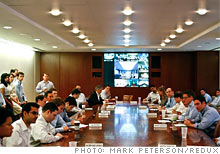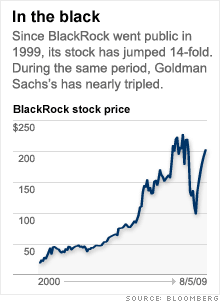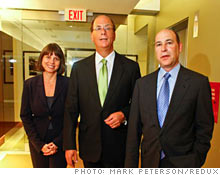Inside the trillionaires' club
With more than $3 trillion in assets, Larry Fink and his team at BlackRock are the world's largest money managers. And Fink thinks he's just getting going.
 |
| BlackRock's daily 8 a.m. staff meeting, which includes execs from around the globe via video |

 |
| Left to right: BlackRock COO Sue Wagner, CEO Larry Fink, and President Rob Kapito |

(Fortune Magazine) -- On Oct. 1, 2008, BlackRock's CEO, Larry Fink, was sitting in his glass-framed Manhattan office when CNBC reported that Warren Buffett was buying a big stake in General Electric. BlackRock's nearby trading floor erupted with excitement. The experts and the pundits on the tube viewed the Buffett news as a sign that the markets were stabilizing. Fink didn't see it this way and shared his gut reaction with an associate.
"This isn't about a sweet, clever grandfather from Omaha making a nice deal! It means GE can't roll over its commercial paper, and corporate America can't fund itself!" As the TV buzzed with happy talk, Fink predicted a new round of fear, panic, and collapsing asset prices, loudly concluding, "This is a disaster!"
It is precisely this type of contrarian, worst-case-scenario thinking that has propelled BlackRock (BLK, Fortune 500) over the past 21 years from an eight-partner bond shop to the best-performing financial services company of its generation. Since BlackRock made its debut on the NYSE in late 1999, its shares have jumped 14-fold, from $14 to $198, creating more than $25 billion in market value. By contrast, Goldman Sachs's just about tripled during the same period.
BlackRock is now by far the biggest, fastest-growing asset manager in the world. When BlackRock completes its $13.5 billion acquisition of Barclays Global Investors (known on the Street as BGI) later this year, it will more than double its assets under management, to $3.1 trillion -- yup, trillion. That's twice as big as its nearest rivals, State Street (STT, Fortune 500) and Fidelity.
BlackRock is also a totally new creation in the world of asset management, a one-stop shop offering a smorgasbord of products to both institutional and retail investors. Unlike banks or brokerages, it does nothing but manage money, and it is the largest provider of fixed-income funds. No wonder Cisco (CSCO, Fortune 500), FedEx (FDX, Fortune 500), and the public school teachers of California trust the firm to help invest their retirement savings.
But as the Book of Luke says, "To whom men commit much, of him they will demand the more." And therein lie the challenges for BlackRock: Can a former bond boutique manage trillions of dollars? What are the thought processes that drive its investment decisions? Can BlackRock deliver consistent returns in an industry where turnover is frequent and talented money managers don't always play nicely with one another?
Answers to these and other mysteries are just some of the secrets that Fortune sought to unlock by spending a month talking with BlackRock executives about how it has flourished during some of the most nightmarish moments in high finance, including 1998's Long-Term Capital Management debacle, 2000's tech crash, and 2008's credit crisis. What follows are four strategies for managing a company and gauging the markets that have driven BlackRock to No. 50 on the Fastest-Growing Companies list.
To understand BlackRock's corporate culture, you need to understand the interplay of Fink and the firm's president, Rob Kapito, who have worked as a team for more than 20 years, and have two very different styles of leadership.
The son of a shoe store owner, Fink is a workaholic who arrives at the office at 5:45 a.m. He spends most of his time on the big picture, talking to important clients, plotting acquisitions, and counseling the Washington regulators who have become a crucial source of business. In his spare time he likes to live well. His brother Steve, a Silicon Valley entrepreneur, describes Larry's property in rustic North Salem north of Manhattan as "Disneyland on a farm." It boasts an indoor riding ring and an 18th-century manor house containing one of the greatest collections of American folk art.
Kapito, 52, is as quiet and precise as Fink, 56, is gregarious and opinionated. Kapito runs the day-to-day operations -- everything from personnel to accounting. He is also the guardian of BlackRock's corporate culture, doing a lot of little things to keep BlackRock feeling familial. One manager found Kapito sitting in her hospital room when she awakened after cancer surgery. In July 2008, Kapito wanted to do something special for the London gold and natural-resources team when their funds reached a milestone of $50 billion. So he flew to London, rented a house, and personally cooked a lamb-chop-and-salmon dinner for the troops, whom he enlisted as sous-chefs with toques inscribed with their names.
Another hallmark of the BlackRock ethos is the daily morning meeting, held at 8 a.m. around a gigantic oval table in a fourth-floor Manhattan conference room. "It's mandatory, like church when you're a kid," says co-chief operating officer Charlie Hallac, who each morning takes the 6:03 a.m. train from his home in Scarsdale, N.Y., with a bunch of BlackRock managers.
More than a dozen offices from around the world -- London, Tokyo, Hong Kong, to name a few -- attend via audio- or videoconferencing. Some satellite offices appear in boxes on a giant screen. It's sort of Hollywood Squares meets high finance. Around the table, managers with nameplates reading "U.S. rates" or "Securitized assets" give pointed, usually one-minute presentations ending with "That's it!"
One morning in July the round of presentations jumped from a description of potash pricing in Britain, to the chances of the government's nationalizing Fannie Mae, to an update on CIT's efforts to raise capital. When participants talk too long, Kapito chides them to keep their presentations brief and pithy.
Aside from Kapito and Hallac, key leaders include COO Sue Wagner and Ben Golub, a Ph.D. from MIT, who is the overlord of BlackRock's risk-management system. These managers devote a lot of attention to employees, who are encouraged to spend their entire careers at the firm -- in fact, the turnover rate is a mere 11%, a figure unheard-of on Wall Street.
Fink prizes loyalty in his people and his partners. He steams when he doesn't get it. A case in point would be his reaction in the summer of 2008 when he learned that Merrill Lynch, which then owned a 49% stake in BlackRock and needed to raise capital, was considering selling that stake. According to close friends of Fink, he called Merrill CEO John Thain and exploded: "Why the [expletive] did I read about this in the paper? Why didn't you tell me to my face?"
The simplest explanation of how BlackRock's strategy differs from that of other bond experts like Pimco: BlackRock does not invest by forecasting which way interest rates are headed. Instead BlackRock wonkishly focuses on the other factors that drive bond values: prepayments and default risk. As a result, BlackRock was better equipped to analyze the complex mortgage securities that came to dominate the fixed-income markets and that caused so much havoc last year.
BlackRock's approach works like this: Say mortgage bonds are selling at a big discount because rates recently rose. BlackRock's models are expert at judging if those bonds are "rich" or "cheap" based on its technology for predicting prepayment trends and defaults. If the model predicts, for example, that prepayments will be higher than most investors expect, BlackRock can garner extra returns because homeowners will pay off their loans at full value, and the fund can reinvest the proceeds at higher rates.
The firm's analytical modeling gets so granular that BlackRock found that people living near IBM offices prepay frequently because IBM executives are often dispatched to new cities. "The BlackRock team is one of the few that can break down those products and assess their true risks," says Michael Rosen of Angeles Investment Advisors, a firm that counsels pension funds and other institutions on choosing money managers.
BlackRock executives are constantly refining their models to stay one step ahead of the latest funky financial product from Wall Street's wizards. "The firms that design securitized products are always conspiring against us with new, increasingly complex instruments," says Rob Goldstein, who oversees BlackRock Solutions, which leases an ultrasophisticated technology platform to clients and has a team that helps companies analyze and run their portfolios. "It's our mission to make sure they don't win." On behalf of the Federal Reserve, BlackRock Solutions is managing troubled assets from AIG (AIG, Fortune 500) and Bear Stearns.
Even with all this quantitative firepower, the company does not always get it right: BlackRock spotted the bubble in subprime, but it misjudged the commercial mortgage-backed securities market.
In late 2006 the company developed a model that put a lower, more realistic number on the incomes subprime borrowers were claiming on their "no doc" loans. The projections were shocking: BlackRock figured that when the loans reset to their new, higher rates in a couple of years, most borrowers would be spending more than half their real incomes on mortgage payments. Foreseeing an avalanche of defaults, BlackRock dumped subprime bonds in early 2007 when the prices were still lofty.
Nevertheless, even the best models can fail when markets go haywire, and that explains how BlackRock simply misread the commercial real estate market. As subprime bond prices plunged in late 2007 and early 2008, the value of real estate securities that BlackRock deemed far more solid dropped as well. By the spring of last year, the interest-rate spreads between Treasuries and commercial mortgage-backed securities (CMBS) -- loans secured by office buildings and shopping centers -- ballooned from 2.5 to 10 percentage points.
BlackRock thought the bonds were a great buy, since the buildings were often fully leased, their AAA tranches had first claim on payments, and the mortgages frequently dated from 2004 or 2005, before lending got wildly excessive. BlackRock placed the bonds in dozens of its funds, often substituting them for Treasuries or corporates, reckoning that they were safe and would produce superior returns.
But by late 2008 the prices of CMBS cratered again, this time sending spreads to an incredible 16 points. It wasn't that the bonds were unsound, at least over the long term. The problem was that highly leveraged hedge funds, REITs, investment banks, and other investors that depended on short-term financing couldn't roll over their commercial paper and other loans, so they were dumping whatever they could sell, including CMBS.
Because of the drag from CMBS, BlackRock's returns were so weak that two-thirds of its bond funds languished in the bottom half of their categories for 2008. The apocalypse Fink predicted as he watched the Buffett announcement on CNBC had trampled even BlackRock's vaunted risk models. "It was a year where the unpredictable turned into the unimaginable," says Fink.
This year the bonds have rebounded strongly, providing a major boost to the company's performance in fixed income. For 2009, BlackRock's 124 bond funds have delivered average returns of almost 20%. Nearly two-thirds rate in the top half of their categories. BlackRock still hasn't caught the benchmarks for the past 18 months, but the gap is narrowing dramatically.
For BlackRock the lesson of 2008 is that "market risk can hurt you, but liquidity risk can kill you," says Goldstein. In other words, BlackRock was prepared to cope with the normal ebb and flow of the market, but not a panic where no one wants to own anything but Treasuries. As a result, BlackRock has now recalibrated its models to predict scenarios where buyers disappear.
To do so, it's tracking the leverage of financial players as never before -- the more leveraged the system, the bigger the chance for another chaotic selloff. It's also advising college endowments and other clients to reduce their exposure to illiquid private-equity investments and hold far more in easy-to-sell bonds or even hedge fund stakes.
BlackRock does not make acquisitions where the main goal is to pare costs by eliminating people and combining similar products. "We've seen in many mergers, both in asset management and banking, that bloodletting doesn't work," says Fink. Instead, Fink prefers to go after firms that add to BlackRock's roster of products and extend its footprint into new international markets.
Nor does Fink want to sell BlackRock to a major bank, in part because he believes that if he did so, other banks would be reluctant to sell BlackRock's products. An illustration of Fink's credo in action was BlackRock's 2006 acquisition of Merrill's asset-management arm, known back then as Merrill Lynch Investment Managers.
Accounting for only 7% of Merrill's profits, MLIM was something of an orphan. The group had built an excellent family of mutual funds, but they were shunned by other brokerages and banks precisely because they bore the Merrill moniker. "Even the Merrill financial advisers were reluctant to sell our funds, because clients would think they favored the hometown product," says Frank Porcelli, who joined BlackRock from Merrill and now heads the U.S. retail business. MLIM executives became so frustrated that they planned on dumping the name and rebranding as Princeton Portfolio Research.
In the Merrill deal, BlackRock followed its classic template: It acquired a business with complementary financial products, stamped its brand on them, and then inducted the conquered people into its culture. One way that Fink does this is by avoiding the toxic power-sharing arrangements that are common in Wall Street mergers, where the head of the division from the acquired company is given a seat alongside the person who runs the same division at the acquiring company. No co-heads, no infighting.
Fink wanted to keep MLIM's talented money managers, so he elevated Bob Doll, a Merrill veteran, to head equities over the BlackRock candidate. All told, BlackRock kept around 2,400 of MLIM's 2,500 employees (BlackRock will have 9,000 employees after the BGI merger), and the deal is a proven winner: Under the BlackRock banner, the former MLIM funds now sell briskly at Morgan Stanley Smith Barney, UBS, Wachovia, and of course Merrill.
BlackRock's independence and lack of its own brokerage business helped it beat out Goldman Sachs (GS, Fortune 500) and Vanguard for the soon-to-close BGI deal. iShares, which is the world's largest family of ETFs, are sold through brokers, and Barclays president Bob Diamond feared that as the bank grew bigger in the securities business, rivals would shun his trophy product. The opportunity to own a 19.9% stake in BlackRock also proved extremely alluring.
The deal's announcement this summer had its comic side. Diamond flew in from London for an interview on Bloomberg TV. When he was dropped off at Bloomberg headquarters in the pouring rain, he discovered that the interview was to be held at the BlackRock building, and that with nothing but British pounds in his pocket, he couldn't pay for a taxi. So Diamond grabbed a young Bloomberg reporter, dragged him into a cab, and got the young man to pay for his ride to BlackRock, where he bummed the bucks to pay him back. "I practically scared the journalist to death," jokes Diamond.
With his trader's gut, Fink is betting that last year marked a paradigm shift in the ways institutions invest their money. He calls it the "new conservatism."
In recent years, pension funds and endowments rushed to diversify into alternative assets like private equity and timberland, which turned out to be highly illiquid when the credit crunch hit. To meet their obligations, those investors were forced to sell their best, most liquid assets at distressed prices.
Now, he predicts they will move to a "barbell" strategy: They will place the bulk of their portfolios in plain-vanilla bonds and indexed equity funds. That tranche will form the low-risk, conservatively-managed end of the barbell. To boost returns, they will stick the rest with a select group of equity managers with sharply-focused strategies and a history of high returns, as well as hedge funds with easy-to-trade financial assets. Private equity investments with their long lockups and illiquid holdings will fall out of favor. "We're in a period where liquidity will be far more important," says Fink.
So the next time disaster strikes and Buffett is snatching bargains from the flames, Fink -- ����and investors with trillions looking to BlackRock to model the unimaginable -- ����will be prepared.
Reporter associate: Sarah Kabourek ![]()
And the winners are...
10 fastest-growing techs
How BlackBerry does it
-
 The retail giant tops the Fortune 500 for the second year in a row. Who else made the list? More
The retail giant tops the Fortune 500 for the second year in a row. Who else made the list? More -
 This group of companies is all about social networking to connect with their customers. More
This group of companies is all about social networking to connect with their customers. More -
 The fight over the cholesterol medication is keeping a generic version from hitting the market. More
The fight over the cholesterol medication is keeping a generic version from hitting the market. More -
 Bin Laden may be dead, but the terrorist group he led doesn't need his money. More
Bin Laden may be dead, but the terrorist group he led doesn't need his money. More -
 U.S. real estate might be a mess, but in other parts of the world, home prices are jumping. More
U.S. real estate might be a mess, but in other parts of the world, home prices are jumping. More -
 Libya's output is a fraction of global production, but it's crucial to the nation's economy. More
Libya's output is a fraction of global production, but it's crucial to the nation's economy. More -
 Once rates start to rise, things could get ugly fast for our neighbors to the north. More
Once rates start to rise, things could get ugly fast for our neighbors to the north. More







